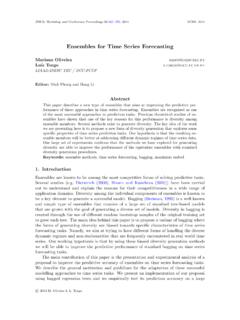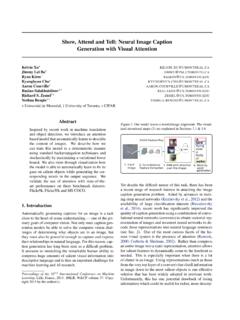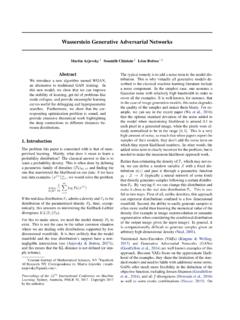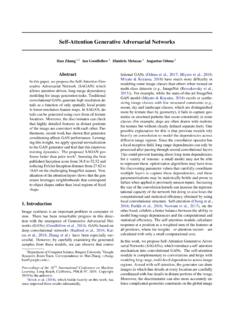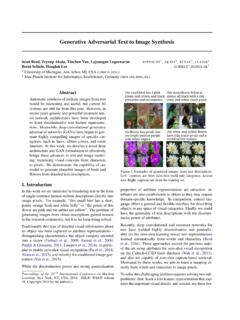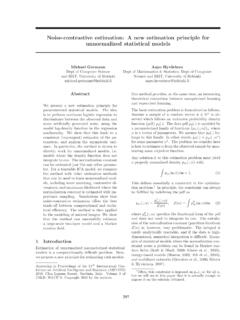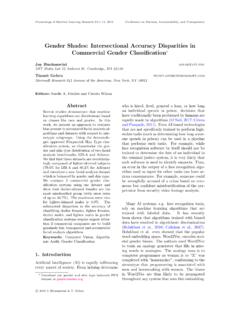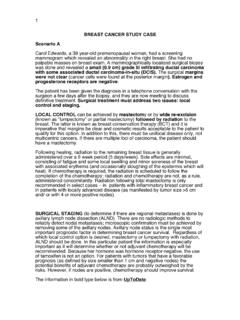Transcription of Gender Shades: Intersectional Accuracy Disparities in ...
1 Proceedings of Machine Learning Research 81:1 15, 2018 Conference on Fairness, Accountability, and TransparencyGender Shades: Intersectional Accuracy Disparities inCommercial Gender Classification Joy Media Lab 75 Amherst St. Cambridge, MA 02139 Timnit Research 641 Avenue of the Americas, New York, NY 10011 Editors:Sorelle A. Friedler and Christo WilsonAbstractRecent studies demonstrate that machinelearning algorithms can discriminate basedon classes like race and Gender . In thiswork, we present an approach to evaluatebias present in automated facial analysis al-gorithms and datasets with respect to phe-notypic subgroups.
2 Using the dermatolo-gist approved Fitzpatrick skin Type clas-sification system, we characterize the gen-der and skin type distribution of two facialanalysis benchmarks, IJB-A and find that these datasets are overwhelm-ingly composed of lighter-skinned subjects( for IJB-A and for Adience)and introduce a new facial analysis datasetwhich is balanced by Gender and skin evaluate 3 commercial Gender clas-sification systems using our dataset andshow that darker-skinned females are themost misclassified group (with error ratesof up to ).
3 The maximum error ratefor lighter-skinned males is Disparities in the Accuracy ofclassifying darker females, lighter females,darker males, and lighter males in genderclassification systems require urgent atten-tion if commercial companies are to buildgenuinely fair, transparent and accountablefacial analysis :Computer Vision, Algorith-mic Audit, Gender Classification1. IntroductionArtificial Intelligence (AI) is rapidly infiltratingevery aspect of society. From helping determine Download our Gender and skin type balanced PPBdataset is hired, fired, granted a loan, or how longan individual spends in prison, decisions thathave traditionally been performed by humans arerapidly made by algorithms (O Neil, 2017; Citronand Pasquale, 2014).
4 Even AI-based technologiesthat are not specifically trained to perform high-stakes tasks (such as determining how long some-one spends in prison) can be used in a pipelinethat performs such tasks. For example, whileface recognition software by itself should not betrained to determine the fate of an individual inthe criminal justice system, it is very likely thatsuch software is used to identify suspects. Thus,an error in the output of a face recognition algo-rithm used as input for other tasks can have se-rious consequences.
5 For example, someone couldbe wrongfully accused of a crime based on erro-neous but confident misidentification of the per-petrator from security video footage AI systems, face recognition tools,rely on machine learning algorithms that aretrained with labeled has recentlybeen shown that algorithms trained with biaseddata have resulted in algorithmic discrimination(Bolukbasi et al., 2016; Caliskan et al., 2017).Bolukbasi et al. even showed that the popularword embedding space, Word2 Vec, encodes soci-etal Gender biases.
6 The authors used Word2 Vecto train an analogy generator that fills in miss-ing words in analogies. The analogy man is tocomputer programmer as woman is to X wascompleted with homemaker , conforming to thestereotype that programming is associated withmen and homemaking with women. The biasesin Word2 Vec are thus likely to be propagatedthroughout any system that uses this 2018 J. Buolamwini & T. ShadesAlthough many works have studied how tocreate fairer algorithms, and benchmarked dis-crimination in various contexts (Kilbertus et al.)
7 ,2017; Hardt et al., 2016b,a), only a handful ofworks have done this analysis for computer vi-sion. However, computer vision systems withinferior performance across demographics canhave serious implications. Esteva et al. showedthat simple convolutional neural networks can betrained to detect melanoma from images, with ac-curacies as high as experts (Esteva et al., 2017).However, without a dataset that has labels forvarious skin characteristics such as color, thick-ness, and the amount of hair, one cannot measurethe Accuracy of such automated skin cancer de-tection systems for individuals with different skintypes.
8 Similar to the well documented detrimen-tal effects of biased clinical trials (Popejoy andFullerton, 2016; Melloni et al., 2010), biased sam-ples in AI for health care can result in treatmentsthat do not work well for many segments of other contexts, a demographic group thatis underrepresented in benchmark datasets cannonetheless be subjected to frequent use of automated face recognition by lawenforcement provides such an example. At least117 million Americans are included in law en-forcement face recognition networks.
9 A year-long research investigation across 100 police de-partments revealed that African-American indi-viduals are more likely to be stopped by lawenforcement and be subjected to face recogni-tion searches than individuals of other ethnici-ties (Garvie et al., 2016). False positives and un-warranted searches pose a threat to civil face recognition systems have been shownto misidentify people of color, women, and youngpeople at high rates (Klare et al., 2012). Moni-toring phenotypic and demographic Accuracy ofthese systems as well as their use is necessary toprotect citizens rights and keep vendors and lawenforcement accountable to the take a step in this direction by making twocontributions.
10 First, our work advances genderclassification benchmarking by introducing a newface dataset composed of 1270 unique individu-als that is more phenotypically balanced on thebasis of skin type than existing benchmarks. Toour knowledge this is the first Gender classifica-tion benchmark labeled by the Fitzpatrick (TB,1988) six-point skin type scale, allowing us tobenchmark the performance of Gender classifica-tion algorithms by skin type. Second, this workintroduces the first Intersectional demographicand phenotypic evaluation of face-based genderclassification Accuracy .
